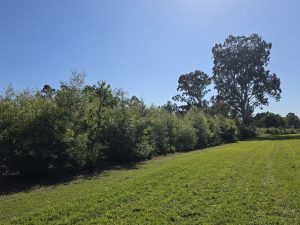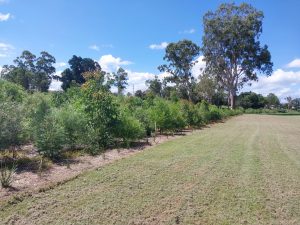Throughout Richmond Valley Council, we have multiple flying-fox camp locations. Within these camps, there is an assortment of Grey-Headed, Black, and Little Red flying foxes. Typically, the Little Red Flying-foxes come through at the start of the year to join the camp locations.
What makes flying-fox populations important and valuable?
Each flying-fox roost is highly important to our surrounding ecosystem and biodiversity. Without these camps, we would lose a significant amount of our native trees and shrubs.
By foraging through our forests, flying-foxes may travel up to 100km a night, pollinating as they go. Most of our native plant species have evolved over 25-40 million years with flying-foxes driving their pollination and dispersal. For example, gum trees produce more nectar and flowers during twilight and nighttime to attract flying-foxes. Without flying-foxes we wouldn’t have Koalas, a species dependent on Eucalypts and significant numbers of native birds would also be without homes. Each flying-fox camp pollinates specific areas surrounding their roost. Without these camps, there would be a gap in pollinators and loss of major vegetation.
Threats to flying-foxes
Following the bushfires of 2019 and intense flooding of 2022, vegetation available to flying-foxes has drastically declined. As a result, there has been over 30% reduction in population numbers.
Significant vegetation clearing continues to be an immense threat to many native species, with flying-foxes suffering mass displacement nation-wide.
In addition to intensifying climate events, other human threats include harmful wildlife netting and barbed wire entanglement are major causes of injuries to flying-fox populations, as well as other species.
Flying-Fox Facts
- Flying-Foxes are social creatures, enjoying spending time together in a camp and chatting away. Each sound they make conveys something different, much like human language.
- The smells associated with flying-fox camps are not from their droppings, rather are made by male’s scent glands to mark their territory. During mating season, this scent becomes more potent but does not pose risk to human health.
- In the event of food shortages, new camps of flying-foxes form. By breaking into smaller groups, the flying-foxes will disperse over larger areas in search of alternate food sources.
- As temperatures rise, individuals throughout colonies will slowly descend to lower down branches to take advantage of shade. During times of intense heat-waves, there is a noticeable difference in what strata flying-foxes are visible at.
Important times for flying-foxes
At different times of the year, flying-foxes develop through different stages of their lives.
From September to November, flying-foxes around the Northern Rivers will give birth to one pup. These pups will stay with their mothers from December to February, being raised by their mothers or in a communal creche within the camp after 6 weeks.
During this time, it is crucial to limit disturbance of the camps as parents are caring for their young. Large disturbances can lead to young being abandoned and increase the likelihood of human or pet interactions.
What is Council doing to protect flying-foxes?

In 2022, Richmond Valley Council successfully secured grant funding through Local government New South Wales as part of round 1 Flying Fox Camp Habitat Restoration Program for the restoration of flying-fox habitat at Queen Elizabeth Park. The project involves planting native tree species, with the goal of creating future habitats for the flying-foxes and relocating the local population further away from residential areas by providing alternative habitat.
Since 2019, Richmond Valley Council has been participating in the quarterly National Flying-Fox Monitoring Program. By keeping record of our local populations, we can report on any significant increases or decreases in numbers.
Continuing from our large-scale planting in April 2023, Richmond Valley Council planted over 12,000 trees along 5.6ha of riverbank as of June 2024. The restoration efforts throughout the site have been successful with a lush riverbank taking shape. Council will continue to monitor the health of the site, maintaining the plantings and controlling invasive/weed species. Some camps of the flying-foxes have recently been observed scouting the newly rehabilitated area, encouraging confidence in the success of the project.
To further develop community engagement with the Project, Council is exploring the idea of installing viewing platforms. This would allow residents to actively watch our camps as they come into roost and migrate through the area.

A permanent transect will also be available for monitoring of soil health, vegetation development and other features. This transect will have a QR code linked to a survey for members of the community to readily access and record their observations.
Below are information pamphlets containing facts and photos relating to our flying-foxes and our planting in Queen Elizabeth Park.
How can you help?
By encouraging wildlife habitat retention and taking care around our flying-fox friendly species, you can help support the flying-fox populations.
Only using wildlife friendly fruit netting and reducing barbed-wire usage, you can prevent major causes of entanglement, injuries, and death of flying-foxes.
Get involved!
Over the next few years, Council will be hosting several events to encourage engagement throughout members of our community on the importance of flying-foxes and other keystone species.
Reporting injured wildlife
If you find injured or deceased wildlife, do not touch, or come into contact with it. Always call a wildlife carer for help. Flying-foxes can carry diseases and although it is highly unlikely for a person to contract these diseases, it is always best to leave contact to a trained wildlife carer.
Relevant helplines include:
Wires Rescue Hotline: 1300 094 737 | www.wires.org.au
Northern Rivers Wildlife Carers: 66281866
